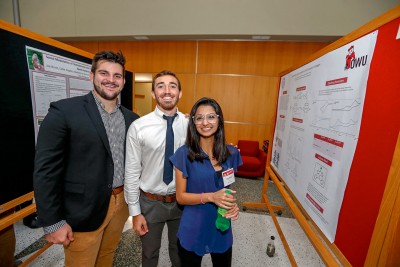Abstract
Redox Active Ligand Scaffold for the Activation of Oxygen
 Students: Jackson Druckenbroad, Ramsha Shah, and Nolan Norman
Students: Jackson Druckenbroad, Ramsha Shah, and Nolan Norman
Faculty Mentor: Allen Pistner (OWU Department of Chemistry)
We are creating an organic molecule called dipyrrin that has the potential to be used in wide ranging applications from cancer treatments to the functioning of fuel cells. Photodynamic therapy, a particular cancer treatment, has been proven to be safer and more targeted than standard chemotherapy. Fuel cells have the ability to supply power with the only by-product being water, which makes the fuel cells more environmentally friendly than using standard gasoline. By using two different routes to synthesize this molecule, we are hoping to find a better and more effective route in forming dipyrrin.
A redox active ligand scaffold, the dipyrrin, was synthesized with the interest in activating oxygen. The synthesis of the scaffold was approached using two different pathways. The original pathway using a published procedure starting with a Negishi-type coupling followed by a condensation with an aryl aldehyde. The second pathway is a new approach, constructing the scaffold from the top down beginning with synthesis of the dipyrromethane followed by subsequent bromination and Suzuki cross-coupling steps. The new pathway provides the opportunity to use more stable and commercially available reagents to potentially improve the overall efficiency of the synthesis. The dipyrrin scaffold was synthesized with a differing aryl group (phenyl or pentafluorophenyl) and was analyzed using UV-vis spectroscopy and electrochemical techniques displaying strong long-wave absorption and redox activity. Attempts in the formation of metal complexes are currently underway.
